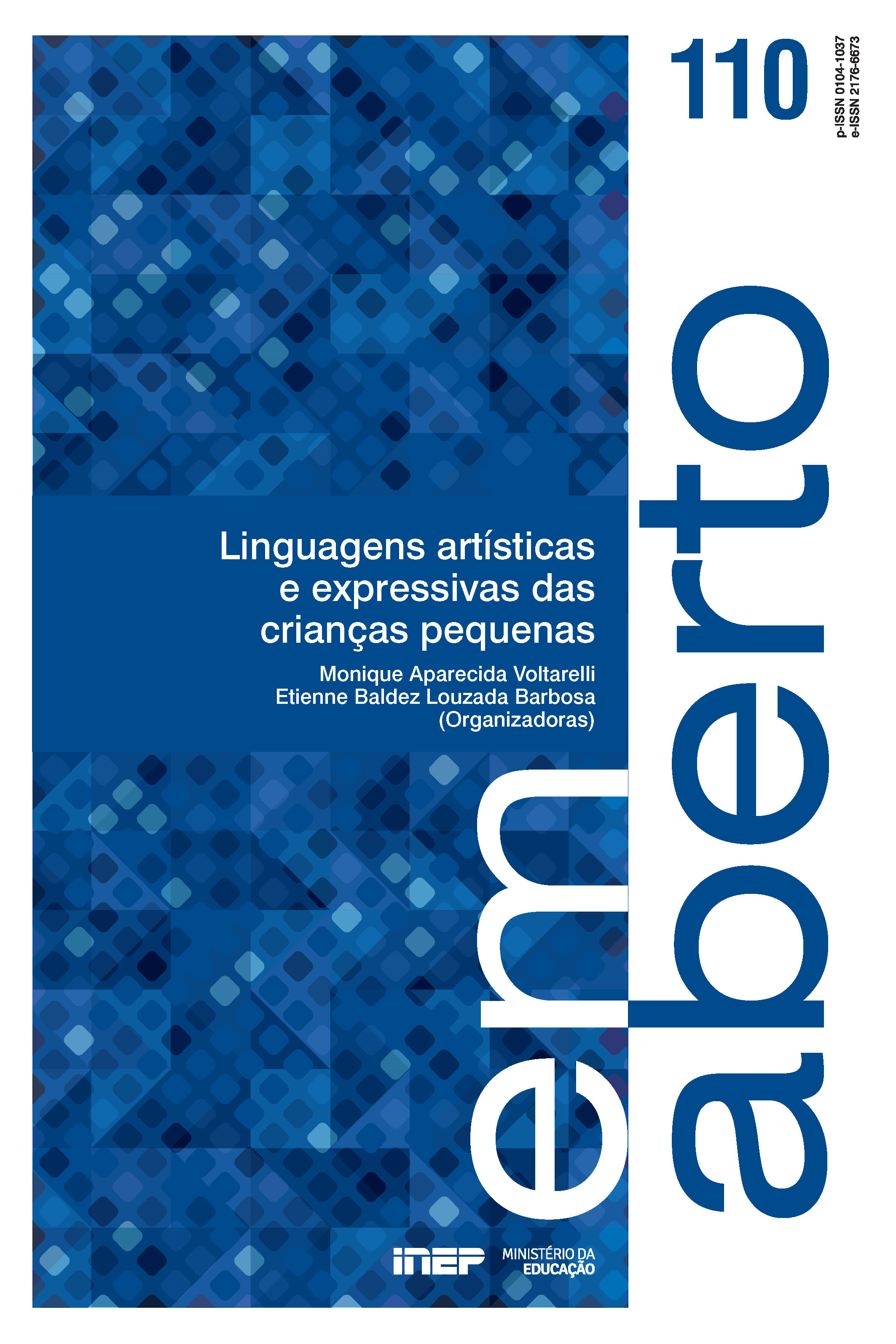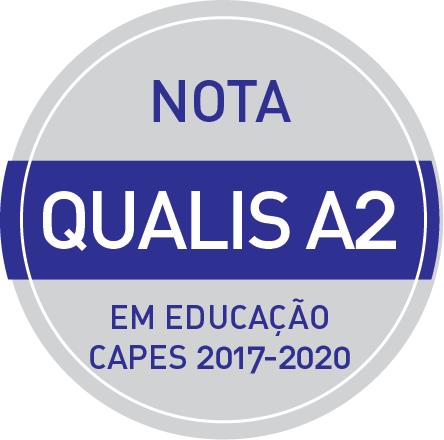Community children choirs in education institutions and its role in the artistic, personal, and social development of the children in its ranks
Abstract
Choral singing, just as musical education, aims to contribute to the personal growth and enjoyment of music, developing musicality in children. Thus, teachers must pose significant-enough musical challenges to children, just as they need to give children the ability to respond to such challenges. Since choral singing is both a musical and bodily activity, it transforms the body, especially the voice, into a musical instrument. As an accessible practice, it requires few resources beyond human material, being able to touch emotions, imagination and affections of singers and listeners. While dealing with children choirs in schools, the playful component is key; therefore, it is up to professionals to seek pedagogical and didactic quality, meeting the tastes and musical practices, not neglecting imagination and creativity. It is advocated that vocal education should be in the hands of professionals who privilege personal attention, emotional support and that promote the ability in children to define a line of conduct of openness to difference, curiosity, permanent discovery and growth.
Downloads
References
AMATO, R. de C. F. Música e políticas socioculturais: a contribuição do canto coral para a inclusão social. Opus, Pelotas, v. 15, n. 1, p. 91-109, jun. 2009. Disponível em: <http://www.anppom.com.br/revista/index.php/opus/article/view/264/244>.
AMATO, R. de C. F. O canto coral como prática sócio-cultural e educativo-musical. Opus, Pelotas, v. 13, n. 1, p. 75-96, jun. 2007. Disponível em: <http://www.anppom.com.br/revista/index.php/opus/article/view/295/273
ARSLAN, A. A study into the effects of art education on children at the socialisation process. Procedia: Social and Behavioral Sciences [online], v. 116, 4114-4118, Feb. 2014.
ASPRILLA, L. I. Educar en la música: una aproximación crítica al talento y la educación musical. Aula, Salamanca, v. 21, p. 63-83, 2015.
BAILEY, B. A.; DAVIDSON, J. W. Amateur group singing as a therapeutic instrument. Nordic Journal of Music Therapy [online], 12, n. 1, p. 18-32, 2003. Disponível em: <https://doi.org/10.1080/08098130309478070>. Acesso em: 12 abr. 2021.
BARTHES, R. Image-music-text. Great Britain: Macmillan, 1978.
BARTLE, J. A. Sound advice: becoming a better children’s choir conductor. Oxford: Oxford University Press, 2003.
BOAL-PALHEIROS, G. Som da Rua, um projecto musical de intervenção social. In: CONGRESSO INTERNACIONAL PEDAGOGIA SOCIAL, 27., 2014, Porto. Anais... Porto: Escola Superior de Educação do Instituto Politécnico do Porto, 2014. p. 378-385.
BOAL-PALHEIROS, G. Singing against loneliness: songs of a homeless choir in Porto. Music and Arts in Action, London, v. 6, n. 1, p. 63-79, Jan. 2017.
BOURDIEU, P. A distinção: uma crítica social da faculdade do juízo. Coimbra: Edições 70, 2010.
CALVI, J.; SOUZA, R.; SANTINI, R. A organização do consumo de música na internet através da classificação do gosto cultural: estudo de caso do sistema de recomendação last.fm. In: CONGRESO ISKO-ESPANÃ, 9., 2009, Valencia. Actas... Valencia: International Society for Knowledge Organization, 2009. p. 663-675. Disponível em: <https://dialnet.unirioja.es/servlet/articulo?codigo=2924551>. Acesso em: 12 abr. 2021.
CAMPBELL, P. Musical meaning in children’s cultures. In: BRESLER, L. International handbook of research in arts education. Dordrecht: Springer Netherlands, 2007. p. 881-897.
CARDOSO, F. A improvisação vocal como ferramenta para as aulas de Educação Musical. Revista de educação musical, Lisboa, v. 137, n. 5, p. 26-34, out. 2011.
CARMINATTI, J. S.; KRUG, J. da S. A prática de canto coral e o desenvolvimento de habilidades sociais. Pensamiento psicológico, Cali, Colombia, v. 7, n. 14, p. 81- 96, 2010. Disponível em: <https://dialnet.unirioja.es/descarga/articulo/3265166. pdf>. Acesso em: 12 abr. 2021.
COLEMAN, J. Social capital in the creation of human capital. American Journal of Sociology, Chicago, v. 94, p. S95–S120, July 1988. Suplement. Disponível em: <https://doi.org/10.1086/228943> Acesso em: 12 abr. 2021.
CORTESÃO COSTA, I. Processos e resultados percebidos sobre a participação em projetos de música coral comunitária com crianças: “...e gostamos de estar à beira dos nossos colegas, a cantar todos juntos!”. 2020. Tese (Doutoramento em Psicologia) – Faculdade de Psicologia e de Ciência da Educação, Universidade do Porto, Porto, 2020. Disponível em: <https://hdl.handle.net/10216/126170>. Acesso em: 12 abr. 2021.
CORVELO, J. G. O coro como veículo de socialização e educação musical: o caso do Coro Comunitário de Amarante. 2013. Dissertação (Mestrado em Música) – Departamento de Comunicação e Arte, Universidade de Aveiro, Aveiro, 2013. Disponível em: <https://ria.ua.pt/bitstream/10773/12173/1/ Disserta%C3%A7%C3%A3o.pdf>. Acesso em: 12 abr. 2021.
DAKON, J. M.; CLOETE, E. The Violet experience: social interaction through eclectic music learning practices. British Journal of Music Education, Cambridge, v. 35, n. 1, p. 57-72, 2018.
FERNANDEZ, O. O canto coral nas escolas. Illustração Musical: Revista Mensal de Cultura e Informações Musicaes, Rio de Janeiro, p. 67-68, mar. 1931. Disponível em: <https://lorenzofernandez.org/o-canto-coral/>. Acesso em: 12 abr. 2021.
FINNÄS, L. How can musical preferences be modified?: a research review. Bulletin of the Council for Research in Music Education, University of Illinois, Urbana-Champaing, n. 102, p. 1-58, 1989.
FREER, P. K. The performance-pedagogy paradox in choral music teaching. Philosophy of Music Education Review, New York, v. 19, n. 2, p. 164-178, 2011. Disponível em: <10.2979/philmusieducrevi.19.2.164>. Acesso em: 12 abr. 2021.
FREGA, A. L. Metodología comparada de la educación musical. 1994. 355 f. Tesis (Doctorado en Música) – Facultad de Humanidades y Artes, Universidad Nacional de Rosario, Buenos Aires, 1994. Disponível em:<http://www.analuciafrega.com.ar/index.php/publicaciones/libros/102-metodologia-comparada-de-la-educacion-musical>. Acesso em: 12 abr. 2021.
HEDDEN, D. An overview of existing research about children’s singing and the implications for teaching children to sing. Update: Applications of Research in Music Education, v. 30, n. 2, p. 52-62, Feb. 2012.
HOULAHAN, M.; TACKA, P. Kodály today: a cognitive approach to elementary music education. Oxford: Oxford University Press, 2015.
KOOPMAN, C. Community music as music education: on the educational potential of community music. International Journal of Music Education [online], v. 25, n. 2, p. 151-163, Aug. 2007. Disponível em: <https://doi.org/10.1177/0255761407079951>. Acesso em: 12 abr. 2021.
LANGSTON, T. W.; BARRETT, M. S. Capitalizing on community music: a case study of the manifestation of social capital in a community choir. Research Studies in Music Education, Victoria, AU, v. 30, n. 2, p. 118-138, 2008.
MENEZES, I. Intervenção comunitária: uma perspectiva psicológica. Porto: Legis, 2007.
MOURA, M. L. de. Projectos artístico-musicais: o contributo do ensino não formal para o desempenho académico e para a consideração das competências musicais no segundo ciclo do Ensino Básico. 2013. 273 p. Tese (Doutoramento em Música) – Escola das Artes, Universidade Católica Portuguesa, Porto, 2013. Disponível em: <http://hdl.handle.net/10400.14/12583>. Acesso em: 12 abr. 2021.
NUNES, M. O mito no rádio: a voz e os signos de renovação periódica. São Paulo: Annablume, 1993.
RAO, D. The children’s chorus: instrument of artistic excellence. The Choral Journal, New York, v. 20, n. 7, p. 5-6, Mar. 1980.
RAO, D. Children’s choirs: a revolution from within: Doreen Rao looks at choral singing as an opportunity for elementary students to develop musicianship, participate in culture, and realize the benefits of self-esteem. Music Educators Journal, v. 80, n. 3, p. 44-48, Nov. 1993. Disponível em: <https://doi.org/10.2307/3398675>. Acesso em: 12 abr. 2021.
RAO, D. Singing in the twenty-first century... singing a better world. In: THE PHENOMENON OF SINGING INTERNATIONAL SYMPOSION, 5., 2005, Newfoundland and Labrador. Procedings... Newfoundland and Labrador: Memorial University of Newfoundland, 2005. p. 248-256. Disponível em: <https://journals.library.mun.ca/ojs/index.php/singing/article/view/610/446>. Acesso em: 12 abr. 2021.
RODRIGUES, H.; MARINHO, T. Caracterização do panorama coral infantil e juvenil do distrito de Lisboa no ano de 2017. Music for and by Children Journal, Aveiro, v. 1, n. 1, Oct. 2017. p. 1-18.
RUIZ, J.; VIEIRA, M. H. Cantem, como se estivessem num prado verde, com ar fresco no rosto...: imagética e metáfora na pedagogia coral infantil. Revista E-Psi: Revista Eletrónica de Psicologia, Educação e Saúde, online, n. 7, p. 3- 17, 2017. Suplemento 1. Volume Especial: Estudos da Criança. Disponível em: <https://revistaepsi.com/wp-content/uploads/artigos/2017/2017-VolumeEspecial-Estudos- da-Crianca1.pdf>. Acesso em: 12 abr. 2021.
SCHAFER, R. M. O ouvido pensante. São Paulo: Editora da Universidade Paulista, 2012.
SEIXAS, A. M. da C. V. Cantar em coro: estudo de caso de uma área do Norte Litoral de Portugal. 2013. 297 p. Tese (Doutoramento em Música) – Escola das Artes, Universidade Católica Portuguesa, Porto, 2014. Disponível em: <http://hdl.handle.net/10400.14/14904>. Acesso em: 12 abr. 2021.
SHELEMAY, K. K. Musical communities: Rethinking the collective in music. Journal of the American Musicological Society, California, v. 64, n. 2, p. 349-390, 2011.
SHIOBARA, M. Collaborative learning in community music activity: enhancing musical and personal lives. In: COHEN, M. L. (Ed.). CMA XIV: listening to the world: experiencing and connecting the knowledge from community music. Salvador, Brasil: International Society for Music Education (ISME), 2014. p. 11-15. Disponível em: <https://www.isme.org/sites/default/files/documents/proceedings/ CMA%20XIV_Full_Proceedings_FINAL_MC.pdf>. Acesso em: 12 abr. 2021.
SKELTON, K. D. The child’s voice: a closer look at pedagogy and science. Journal of Singing, [online], v. 63, n. 5, p. 537-544, May/June 2007.
SMITH, B.; SATALOFF, R. T. Choral pedagogy and the older singer. San Diego: Plural Publishing, 2013.
SPENCER, H. The origin and function of music. In: SHEPHERD, J.; DEVINE, K. (Ed.). The routledge reader on the sociology of music. New York: Routledge, 2015. p. 27-33.
SWANWICK, K.; LAWSON, D. “Authentic” music and its effect on the attitudes and musical development of secondary school students. Music Education Research, [online], v. 1, n. 1, p. 47–60, 1999. Disponível em: <https://doi.org/10.1080/1461380990010105>. Acesso em: 12 abr. 2021.
TITZE, I. R. The human voice as a biological musical instrument. In: SUNDBERG, J.; NORD, L.; CARLSON, R. Music, language, speech and brain. London: Springer, 1991. p. 232-242
TOLBERT, E. The enigma of music, the voice of reason: “music, language”, and becoming human. New Literary History, [online], v. 32, n. 3, p. 451-465, 2001.
TONNEIJCK, H.; KINÉBANIAN, A.; JOSEPHSSON, S. An exploration of choir singing: achieving wholeness through challenge. Journal of Occupational Science [online], v. 15, n. 3, p. 173-180, 2008. Disponível em: <https://doi.org/10.1080/14427591.2008.9686627>. Acesso em: 12 abr. 2021.
TURINO, T. Music as social life: the politics of participation. Chicago: University of Chicago Press, 2008.
Copyright (c) 2021 Em Aberto

This work is licensed under a Creative Commons Attribution-NonCommercial 4.0 International License.
These are the terms of this Copyright Notice:
- I declare that I permanently forfeit in favor of the National Institute of Educational Studies and Research (INEP) all rights related to:
-
- editing, publication, reproduction, and distribution of the work;
- publication through digital and electronic media;
- translation of the work to any language;
- updating, re-printing, adaptation, and compression of the work;
- uploading of work in the publishing platform of INEP;
- divulging complete or parts of work through the World Wide Web (internet), whether in Brazil or foreign countries;
- authorization of third parties to execute any of the acts mentioned before.
- I explicitly declare that I am solely responsible for the opinions expressed in the work, and its publication does not violate the rights of third parties.
- I declare that the nature of said work is one of pro bono publico and, as such, I forfeit the right to any compensation regarding ownership rights granted.
- I authorize spelling and grammatical review of the manuscript, provided that the content and opinions therein remain unchanged.












